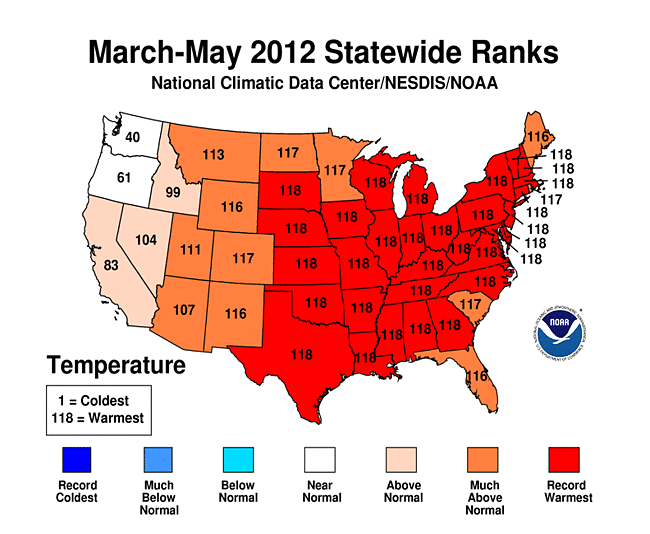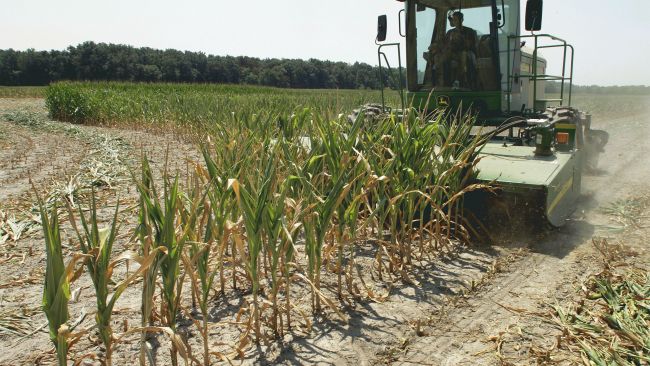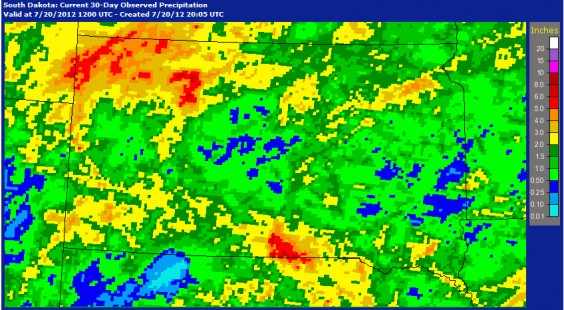Above: Steve Niedbalski chops down his drought-stricken corn for feed in Nashville Ill. AP photo via Weather.com (http://www.weather.com/news/drought-disaster-photos-20120713?pageno=10)
While northeast South Dakota has been blessed with just enough rain to keep farmers’ hopes alive that we might still get a decent crop, most of the country has not been so lucky.
News outlets around the country are reporting on the drought and its effects. Here is a roundup of what Dakotafire has seen and heard in the past few days:
- Drought still looming: Immediate relief unlikely, from the Aberdeen American News. From that story, check out the graphic comparing what parts of the nation were hit by drought last year, and how much more of the map is colored this year:
Shaded U.S. map showing severity of drought conditions across the country, from abnormally to exceptionally dry. Los Angeles Times/MCT 2012 by Molly Hennessy-Fiske (Staff / July 19, 2012), via Aberdeennews.com
- State Climatologist Dennis Todey on Dakota Midday: The worst-hit areas of South Dakota are in the southeast and west. The area from Aberdeen to Day County received a little relief–up to 4 inches in Webster this week. Most areas have received far less rain than is needed to sustain plants.
- Dennis Todey was also quoted in a Britton Journal story on July 18. From the story: “Conditions since the spring have been somewhat dry over most of the state. Most problems have worsened recently with a lack of precipitation over the last 30 to 60 days,” Todey said. “A major driver of this drought has been temperatures, which have been running consistently warm since the spring and winter,” Todey said. “Increased temperatures have increased plant water use and exhausted limited soil moisture reserves. The last 30 days have continued this trend, being four to eight degrees above average across the state.”
- Dennis Todey updated his report on July 20 with an even worse assessment. “Most of the southern half of the state is in D2 (Severe Drought) while most of the rest of the state is in D1 (Moderate Drought),” Todey said. Todey also noted that it was the warmest spring on record in South Dakota. Note number of record warmest days in South Dakota from March through May:

- Faulk County row crops are looking bleak without the prospect of more rain, the Faulk County Record reports. This quote from Kirk Hoefert in Seneca: “Things are holding on, but it’s getting kinda mean out there. The winter wheat was great. Guys are just getting going on the spring, but the winter wheat was tremendous. Guys saw yields for 60, 80 even up to 100 bushels per acre. Makes a lot of guys wish they’d planted more of it. Still, if we can get some rain we’ll be able to salvage some of these row crops. We just hope that Mother Nature will turn on the spigot soon.”
- Report on your level of drought condition at this Farm Forum poll, or send your report on how you’re dealing with the heat to the Reporter & Farmer via their Facebook page.
- Check out the precipitation report for the last 30 days. Surprisingly, northwest South Dakota has fared the best in that period. The area Dennis Todey mentioned on “Dakota Midday,” from Aberdeen to Day County, is also visible here:
- Widespread Drought is Likely to Worsen, by the New York Times. “What is particularly striking about this dry spell is its breadth. Fifty-five percent of the continental United States — from California to Arkansas, Texas to North Dakota — is under moderate to extreme drought, according to the government, the largest such area since December 1956.” Also check out the Drought Footprint graphic, showing how much of the nation has been in drought status for most years going back to 1889.
- NPR’s Talk of the Nation program addressed the drought on Thursday.
Some quote highlights:- “If you just look at the maps and at the amount of precipitation, it looks maybe a little worse than it really is because farming techniques have improved so dramatically since the ’50s or ’30s. And part of it has to do with these plant varieties that are just very, very hearty and also farmers who have gotten very good at putting the water on the roots of the plants, not, you know, down the creek.” That was from Frank Morris, news director at KCUR in Kansas, Missouri.
- And from Mark Svoboda, a climatologist at the National Drought Mitigation Monitoring Program at the University of Nebraska Lincoln: “We’ve been doing that map since 1999 now, and over that time we have never seen this much percent of the U.S. or at least the lower 48 states covered in drought. Currently that number is about 64 percent.”
- Drought Affects Large Swaths of U.S.: Author William deBuys speaks to Renee Montagne about the drought: “The shocking thing is the number of new high temperature records. This is such a hot, hot drought. … In June the nation 2,284 daily high records,” which means there is more an effect on plants than there would be if there was a lack of precipitation with milder temperatures. DeBuys says lack of rainfall is going to be the “new normal” for us.
- A chart from Bloomberg.com shows that current corn conditions are far worse than average, getting close to the condition of the drought year of 1988.
- The Weather Channel has an interesting story comparing the current drought with the Dust Bowl and drought of the 1930s. Basically, although there are similarities, we aren’t at that stage of crisis yet.
- Weather.com also has a photo essay of what the drought looks like around the nation. The photo at top is from that collection.
- Grain prices are up on Friday on the Chicago Board of Trade, according to this Washington Post report.
What good drought stories have you seen? How is the drought affecting you? Comment below!
 Dakotafire Get your spark here.
Dakotafire Get your spark here.




